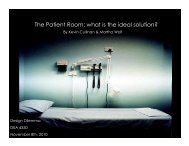The role of physical design and informal communication
The role of physical design and informal communication
The role of physical design and informal communication
You also want an ePaper? Increase the reach of your titles
YUMPU automatically turns print PDFs into web optimized ePapers that Google loves.
ecause as a visitor entered the unit <strong>and</strong> needed information about the location or<br />
status <strong>of</strong> a patient, the first encounter they had was with staff at the three large<br />
rectangular desks in the front <strong>of</strong> the unit (Desks B1). Recall that the people at these<br />
desks, <strong>of</strong>ten physicians <strong>and</strong> members <strong>of</strong> allied health, would not readily have this<br />
information available. Consequently, physicians were interrupted during<br />
documentation to redirect visitors to the back <strong>of</strong> the unit to speak with the charge<br />
nurse. Nurses’ work flow was also frequently disrupted for the same reason. <strong>The</strong><br />
initial observations made by the NM revealed that the CN <strong>and</strong> UR should be<br />
repositioned to the front <strong>of</strong> the unit at Desk B1 to better serve visitors (Figure 14). As<br />
a result <strong>of</strong> this change, doctors began to un<strong>of</strong>ficially claim the now quieter Desk B2 as<br />
their location for documentation tasks, which led to fewer interruptions <strong>and</strong><br />
distractions. It is important to note that this change occurred over time between mid<br />
<strong>and</strong> late February, <strong>and</strong> thus the locations <strong>of</strong> “charge nurse” <strong>and</strong> “nurses station”<br />
became somewhat blurred for a time. Consequently, the information collected by the<br />
CWM tool concerning these two locations after the change may be inaccurate to some<br />
extent.<br />
<strong>The</strong> second <strong>physical</strong> change made by the new NM was the relocation <strong>of</strong> the<br />
patient charts. Before the change, the charts sat in a large, tall rotating chart carousel<br />
on Desk A1. This carousel was large enough that it reduced visibility across the unit.<br />
Recognizing seemingly minor <strong>design</strong> factor as a significant obstacle to <strong>communication</strong><br />
<strong>and</strong> sense <strong>of</strong> cohesion, the NM moved the charts out <strong>of</strong> the major lines <strong>of</strong> sight to<br />
location A2 on a wall-mounted organizer (Figure 15). One nurse described the<br />
increased visibility that resulted:<br />
“It didn’t seem like a big deal when they (the charts) were there,<br />
but as soon as they were gone, it seemed less cluttered. It seemed like<br />
46







